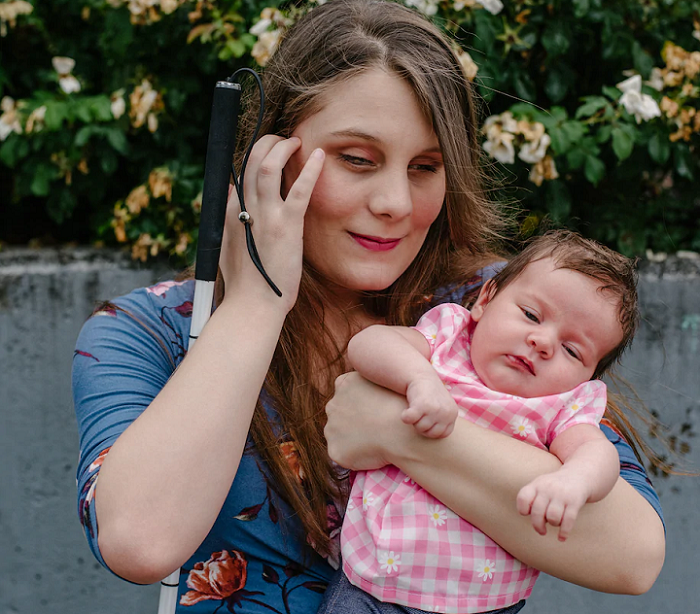People who are blind use their hands to see what their eyes cannot, and 3D printing has been very helpful in creating more tactile opportunities and experiences for the visually impaired, whether it’s learning math skills or taking medication independently. The technology can also help give blind parents-to-be a really important and powerful experience: the chance to “see” their baby’s face before birth.
Melissa Riccobono, President of the Maryland Parents of Blind Children, a division of the National Federation of the Blind (NFB), said, “For families, instead of having to show them a picture of an ultrasound, how cool it would be for them to get their hands on it, what the baby is like now.”
By using 3D images from ultrasounds to create a model of the fetus, visually impaired mothers and fathers can actually handle and feel their unborn baby’s face, which is obviously a very meaningful experience as they can’t see the typical 2D ultrasound photographs.

Taylor Ellis and 6-week old Rosalie. Ellis is blind but technology allowed her to get a 3D bas-relief model from the in utero ultrasound image of Rosalie’s face. “It feels super-real when you can feel it,” she says, adding it was like she was pregnant for the first time because she had so much detail.
26-year-old Taylor Ellis of Cockeysville, MD, who is blind, received a 3D bas-relief of her daughter Rosalie’s face while she was still pregnant with her.
“I was a little bit nervous about opening the box. I had never seen a 3-D [image], and now, it’s your baby, and it’s, like, wow,” Ellis said about the “really emotional” moment.
While we’ve seen a few companies offer this service, this particular version of the idea came about several years ago, when Dr. Jena Miller, an obstetrician and surgeon with the Johns Hopkins Center for Fetal Therapy, realized she could use 3D printing to get a clearer image of the spines of babies she was treating in utero for spina bifida, a malformation of the vertebrae that exposes the spinal column. The surgery she performs is minimally invasive, but still tricky, as it’s conducted through two small ports in the expectant mother’s uterus. But by creating a 3D printed model of the baby and placing it inside a soccer ball, the surgical team can practice the procedure ahead of time.
Dr. Miller explained that typically, 3D ultrasounds are just for diagnostic purposes, but said one of the hospital’s ultrasound sonographers had the idea to make 3D printed ultrasound models of the baby’s face when completing a scan for a visually impaired mother. She asked Dr. Miller, who answered, “See if you can capture a good picture.”
High school teacher Pamela Lauer is not blind, but ended up being the first Johns Hopkins parent to receive a 3D printed model of her baby’s face, due to the fact that 3D ultrasounds were needed for her unborn son, who developed a congenital cyst that was affecting his heart. Because the technicians saw how interested Lauer and her husband were in the technology, they sent the new parents a 3D print of his face after they were home from the hospital.
“That was awesome and amazing. It looks like him,” Lauer said about the model of her son, who is now almost four years old and healthy.
Ellis and her husband Jeremy, also visually impaired, already had two daughters, and she still had some vision when they were born. But her glaucoma has progressed since then, so getting the 3D printed model of Rosalie’s face was really exciting, as it offered so much more detail. For example, she was hoping the baby would have her husband’s nose, and not hers.
“The one thing that is just super-distinct and obvious and just perfect is the nose. It feels just like my husband’s,” Ellis said about the model.
Riccobono and her husband Mark, the President of the NFB, along with two of their three children, are blind, and she wished that 3D prints of the faces of her unborn babies had been available when she was pregnant.
Riccobono said, “It was always a little sad for me not to be able to actually see that ultrasound.
“It’s a really cool way to meet that little being inside of you before you actually meet that little being.”
She believes this would be an amazing service for many expectant parents.
Dr. Miller has not heard of other hospitals offering this 3D printed ultrasound service, which costs about $1.40 in materials and takes about 3.5 hours to print. While she agrees with Riccobono, she does note that ultrasounds are still diagnostic tools and “not for fun.”
“We have to be a little bit careful,” she cautioned.
“But we should take every opportunity to enhance the pregnancy experience for moms, no matter what it is they’re challenged with.
“So if it’s blind moms, and we can give them a unique experience, we should always elevate their level of care.”
(Source: The Washington Post / Images: Andrew Mangum for The Washington Post)
The post Blind Parents “See” Baby’s Face with 3D Printed Ultrasound Models appeared first on 3DPrint.com | The Voice of 3D Printing / Additive Manufacturing.


